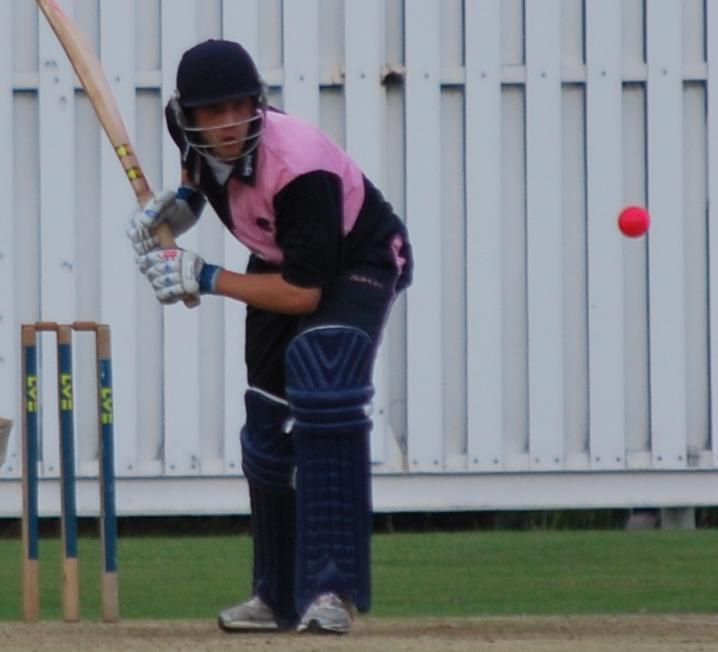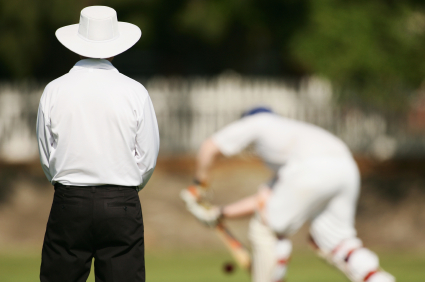|
|
|
|
Hi,
If you have cricketing aspirations, this is the newsletter for you.
Budding professionals can take a leaf from the book of Josh Davey who recently signed terms with English county Middlesex. Indian fans and those interested in big game strategy can get the inside track on how the team got to the 2003 World Cup final. Reluctant umpires also get a nod with our look at how to be a good stand in. Next time you give an LBW you can stand by your decision confidently!
Finally we spark some discussion with our controversial article on exercises that hurt your cricket (and your back) as well as the miCricketCoach Show: around 30 minutes of cricket coaching chat for you to listen to.
Have a great weekend,

David Hinchliffe
|
|
|
|
 |
Living the dream: Cricketer reveals how he won a professional contract |
 |
|
|
 In August 2009, 19 year old Josh Davey was awarded a contract with Middlesex County Cricket Club. How did he do it? In August 2009, 19 year old Josh Davey was awarded a contract with Middlesex County Cricket Club. How did he do it?
When you watch the top professionals, you might assume it was all very easy. Natural talent brought them to the top with no real effort. The best players always make the game look simple. As Josh's example shows, this is not always the case. Here are 4 big reasons Josh made it while others of similar talents fell by the wayside.
Find the best coaches
We all know that good coaching creates good cricketers. Josh made it his mission to find the best. As his father revealed, "Josh wanted to become a professional cricketer and train through the winter. After searching the internet and asking our local cricket experts we found Gary Palmer's CCM Academy."
Josh got through the trial and was exposed to a very intense series of coaching sessions lead by PitchVision Academy Elite Coach, Gary Palmer. CCM Academies are always staffed by former international or first-class cricketers so Josh was learning from the best. The Academy has a reputation for its intensity, as miCricketCoach found out when we attended a session in April of 2009. It certainly worked for Josh who said the coaching, "enabled me to progress my game to a level that got me noticed by the first class counties."
Go the extra mile (or 320)
For Josh, getting to the Academy was not easy; "Every other Sunday for 5 months we were up before dawn to start the 320 mile round trip." The commitment to long days shows how much Josh was prepared to put into making it. The lesson is simple: If you want to be a professional, sometimes you need to do the uncomfortable things to put in the work.
Play a high standard
Josh also made sure he was playing a high standard of cricket. Minor county, school and club cricket can only teach you so much. Josh also played several games for CCM Academy. These matches were against first-class county Academy sides: "The academy games enabled me to assess my ability compared with boys in first class academies, as well as providing competitive match situations and gain experience under pressure." He revealed.
Have exceptional support
Nobody can make it alone. Josh was supported in several ways by understanding parents and the PCA. Even the most talented players need help if they are going to make it. The secret is to seek out help where possible and don't give up if you have a setback. Financial and practical hurdles can always be overcome if you have people to help you.
Despite Josh's natural talent, the road to professional cricket was not an easy one. His story is one of determination and hard work. We all wish him luck with his professional contract.
Is it your turn next?
If you have the talent and are aged 10-20 in the UK, don't die wondering. Enrol on the CCM Academy for 2009-10.
Discuss this article with other subscribers
|
|
|
 |
How India prepared for the World Cup |
 |
|
| |
The following article is an extract from Now or never: The Inside Story of the Indian Cricket Team at the 2003 World Cup by the team analyst: Shayamal Vallabhjee. In this section Shayamal tells us some of the plans India put into place before the tournament started.
The Indian contingent stayed at The Spier Wine Estate for our first match.
At Spier, we had our first major team meeting which was conducted by John and Dr Sandy Gordhon. That was probably the most important and informative meeting I had ever attended. We discussed everything, laid down some rules, developed games plans, and created platforms for speech that were to pave our way forward. Contributions from every individual were integral to a successful campaign. John’s calm disposition and Dr Gordhon’s insight into the workings of the Australian Cricket Team provided an atmosphere and aura to behold. We were all focused on the goal, and determined to contribute.
Cohesion was identified as completely integral to our success, so we made some house rules to aid us in achieving our goals.
- Do not let media pressure and pressure from India (home) get to you.
- Do not be aggressive - be supportive in a quiet manner – do not let others see that there are pressure problems within the game.
- The team performance on the field is like a disease – it spreads to all players. Ensure that you spread a good vibration of commitment and determination to win.
- Players must all understand their roles in the team. We must appreciate every contribution towards the team’s performance. Showing appreciation breeds confidence which develops winning habits.
- Do not be complacent – remind each other of their roles and the team goal.
- We lack the killer instinct – people must be brave enough to give constructive criticism, and others must be man enough to listen.We cannot afford to switch off during any part of the game.
- The day before the match is crucial – the way we prepare sets the trend for the match.
- Warm ups are 50% physical and 50% mental. – be prepared for both aspects of the game.
One of the final tasks of the meeting was to appoint a batting captain, a bowling captain, and a fielding captain. There job was to evaluate the team’s respective performances in the various fields in accordance with the team goals and plans. This was hugely important for two fold reasons:
It helped Saurav Ganguly on the field, as he had junior captains evaluating performance whilst he could strategize. It also turned every member of the team into an analyst, which kept them completely focused.
Secondly and more importantly, it provided a platform for the youngsters to speak openly and without the fear of criticism. This with time aided in them being more expressive both on and off the field. John was instrumental is directing the information in the right channel and at the correct time.
The captains and game plans were as follows:
- Batting Captain: Rahul Dravid and Yuvraj Singh
- Bowling Captain: Anil Kumble and Zaheer Khan
- Fielding Captain: Yuvraj Singh and Mohammed Kaif
Batting Game Plan
- Emphasis on Partnerships
- As a team we want to achieve (1 x 100 runs) by an individual and (1 x 100 runs; 2 x 50 runs) in partnerships.
- Wickets in Hand
- At the fall of each wicket, the next pair must try to put on a 20 run partnership minimum. This will avoid consecutive wickets falling and two new batsmen at the crease.
- Always run the first run hard.
- When batting in the last ten overs, try to look for the boundary in the first two balls of the over.
- Trust your boundary hitting instincts and look for plenty of singles.
Bowling Game Plan
- Minimize extras. No wides or no balls. This begins with discipline at practice.
- No short pitched deliveries.
- We want two early wickets. Preferably in the first ten overs.
- Stress the importance of dot balls.
- Bowl in partnerships.
- Start and finish the over well: Try to avoid boundaries of the first and last delivery.
- Minimize boundaries in the last ten overs.
- Give off 100% in the second spell to try to set up the game for us, irrespective of the situation.
- Minimize experimentation.
- Anil Kumbles Tip: If you are struggling with your line and length, try to imagine that there are only two people on the ground (You and the wicketkeeper). If teaches you discipline.
Fielding Game Plan
- Try to average two run outs per game.
- Always be alert on the field.
- Throwing to the wicketkeeper must be of the highest quality.
- People must be prepared to throw themselves around for the team.
- Intensity levels must be high and low, but never switched off.
- Involvement is crucial. Always read the situation.
- Always pay attention to the captain and wicketkeeper.
- Standardize our approach to the game. The intensity during the warm up sets the trend for the game.
- Each fielder must endeavor to end with a + 2 against his name. (A miss field which results in two runs is a -2. A good save that results in a run saved is a +1.)
- Always be positive and encouraging on the field.
-
We now had a blueprint of what was required to ensure a successful Cricket World Cup. All that was needed was to practice our plan, execute it diligently, show courage and determination in the face of adversity, and be humble in success.
Click here to purchase Now or Never: The Inside Story of the Indian Cricket Team at the 2003 World Cup
image credit: B. Sandman
Discuss this article with other subscribers
|
|
|
|
|
 |
Don't be a bad stand-in umpire |
 |
|
| |
 Players, coaches or spectators roped in to umpire club cricket matches all want the same thing: To keep mistakes to the minimum and let the players enjoy the match. But it's tricky if you are not a qualified umpire. Players, coaches or spectators roped in to umpire club cricket matches all want the same thing: To keep mistakes to the minimum and let the players enjoy the match. But it's tricky if you are not a qualified umpire.
No wonder you are a little reluctant to do it.
You can do a good job without having to memorise the Laws, a little preparation and application of common sense can go a long way to stopping you making the wrong decisions when under pressure.
Have a good rapport with players
Applying the Laws is only one part of the umpire's job. As much as possible he or she should look to let the players play the game without being overly officious. This in itself will improve the goodwill between you and the players, reducing the chance of someone feeling you are acting unfairly.
You can add to this by being polite. Its good manners to answer every appeal (even if it's not out), or call 'over' loud enough for everyone to hear. If a player is questioning your decisions, stay firm and tell him or her that they may not agree, but a decision has been made so the game must continue.
Know the basics
There are some simple things that you should be clear about before agreeing to umpire:
- Having counters to count the balls in the over (stones or coins will do). Most umpires also get in the habit of checking with the other umpire when there are 1 or 2 balls to go in the over.
- Stand close enough to see everything from either umpiring position. It's also important to move into position quickly for run out appeals. If you are at square leg you can walk in a few paces, if you are at the bowler's end you move to level with the popping crease on the same side as the ball has gone.
- Be comfortable with what counts as a no ball. This can be front or back foot, full pitched or too many bounces.
- Be aware of what counts as a wide. In most club games a wide is a ball that the batsman can't hit from his normal stance. However, if he moves you must take this into account.
Know the 4 steps of LBW appeals
LBW appeals are the most difficult to deal with because they all take an element of guesswork. To make it easier, there are 4 questions you need to ask before deciding if the batsman is out. You must answer 'yes' to all these questions:
- Did the ball pitch in line between wicket and wicket (or on the off side)? If it pitches outside leg stump it can't be out.
- Did the ball hit the pad first?
- Was the interception between wicket and wicket? The ball has to hit the pad between wicket and wicket if the batsman was playing a shot. If he was not playing a shot (for example leaving the ball) the ball can hit the pad 'outside the line' on the off side.
- Would the ball have hit the stumps? Based on your judgement of where the ball would have gone if it had not hit the pad you need to decide if it was going on to hit the stumps. Take into account how much the ball is moving, how far forward the batsman is playing (the further forward the harder to judge) and the height of the ball on impact.
Find out the local rules
Make it a point before you go to umpire that you know any rules specific to the competition or to the ground.
For example, some grounds have trees within the boundary. Different clubs play this obstruction in different ways (a clean hit on it may be four or may be six). Also, limited over games often have increased fielding restrictions.
While this is a far from comprehensive guide to being an umpire, applying these basics will make things run smooth more often than running rough. More difficult or rare situations might require the skills of a qualified umpire (or a Laws anorak).
If you want more detail on being stand-in umpire, check out the interactive course on PitchVision Academy: The Umpiring Survival Guide for Players, Coaches and Non-Umpires. It's designed to cover the basics of umpiring for people who have to do it but don't want to go through a full umpiring qualification.
Discuss this article with other subscribers
|
|
|
|
|
|
5 exercises no cricketer should do. Ever.
|
| |
Absolutes are a rare thing. The phrase 'it depends' is always hanging close to the lips of good cricket coaches and fitness trainers. There are always exceptions to rules.
Except in this list.
When I see people doing any of these exercises in the gym I just want to wince. Partly because they wasting their time. Sometimes because it's downright risky. Mainly because their heart is in the right place (they came to the gym after all) but their execution is all off.
Read More...
|
|
|
|
|
Cricket Show 51: Twenty20
|
| |
It's crash, bang and raining sixes this week as the show goes all Twenty20. The shortest format has been played for many years in evening cricket at the amateur level, long before the professionals took it up. So Kevin and David take a look at some of the techniques and tactics of the game.
Questions this week include
Read More...
|
|
|
|
|
|
|
 |
| About PitchVision Academy |
|
|
 |
|
| |

Welcome to this week's guide to playing and coaching better cricket. I'm David Hinchliffe and I'm Director of the PitchVision Academy team. With this newsletter you are benefitting directly from over 25 Academy coaches. Our skills include international runs and wickets, first-class coaching, cutting-edge research and real-life playing experience. |
|
|
|
|
|
|
|
|
|
|
|
| |

Do you have a friend or team mate who would be interested in this newsletter? Just hit "forward" in your email program and send it on.
If you received this email from a friend and would like to get subsequent issues, you can subscribe here.
Enjoy!
|
|
|
|
|
|
|
|
|

.jpg)




.jpg)


